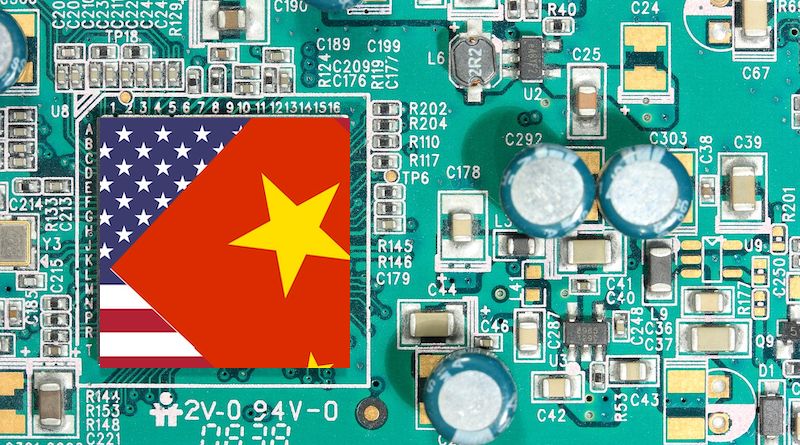Megha Shrivastava

Some China observers contend that Washington’s export control strategies incentivise Chinese enterprises to bolster their self-reliance. Nvidia, a US chipmaker, has garnered attention for consistently introducing ‘China-specific’ redesigned chips, relieving Chinese chipmakers grappling with business constraints.
Following the implementation of export control measures, Nvidia’s 2023 revenue and stock prices surged. During a visit to China in January 2024, Nvidia’s CEO Jensen Huang referred to 2023 as a ‘dream year’ for the company. Nvidia commands approximately 90 per cent of China’s chip market, particularly in artificial intelligence (AI) chips.
TrendForce, a Taiwan-based technology consultant, forecasts that by 2030, Nvidia’s revenue from China will decrease to less than 50 per cent. Nvidia identified China’s tech giant, Huawei Technologies, as its most significant competitor in its annual report.
Despite heavy dependence on Nvidia’s leading-edge chips, Chinese chipmakers are showing a diminishing interest in the company. Market leaders in China have expressed growing apprehensions about buying more stock from Nvidia, citing significant downgrades in chip performance leading to cost inefficiencies.
A rising number of Chinese chipmakers believe that a sustained, long-term partnership with Nvidia is untenable, prompting them to explore domestic alternatives. In their pursuit of long-term stability, Chinese chipmakers seem inclined to endure short-term challenges, with China’s Huawei emerging as a prominent contender.
Huawei’s diligence in promoting Chinese innovations has ensured long-term trust in domestic innovative capabilities. Huawei’s breakthrough success with a 7nm AI-powered chip has regained confidence in China’s chip market against US sanctions. Huawei’s priority to replace Nvidia’s position in the domestic market is an effort to reduce reliance on foreign advanced graphic processing units, vital to AI training, gaming and electronic vehicles.
Despite being in the advanced stage of development, Huawei’s Ascend 910B chip has already made headwinds in the market and is expected to deliver 80 per cent efficiency compared to Nvidia’s H100 and H800 chips. It is a preferred alternative to Nvidia’s downgraded chips for Chinese chipmakers.
Following the 2023 revision of export controls, demand for Ascend 910B surged and Chinese chipmakers were willing to pay a premium. Baidu, a significant player in AI, quickly expressed interest in Huawei’s chips. Even before the US Department of Commerce imposed its proposed rules and the Ascend 910B chip specifications were revealed, Huawei collaborated with Baidu to advance its large-scale AI modelling infrastructure.
This initiative aims to establish an open ecosystem utilising Huawei’s HiAI platform and Baidu Brain — a compilation of the company’s AI assets and services. The collaboration will leverage Huawei’s neural network processing unit and Baidu’s PaddlePaddle deep learning framework to empower AI developers.
While continuing to place substantial orders with Nvidia, Baidu was among the first to order Huawei’s Ascend 910B chips. Other Chinese AI companies and telecom operators have initiated testing of intelligent cluster modelling based on Huawei’s Ascend 910B.
Huawei is reportedly developing a proprietary software platform for companies to perform AI modelling — an area where Chinese AI giants have traditionally relied on US platforms. It remains to be seen whether and when Huawei’s proprietary software platform will be ready and how efficient it will be in enabling Huawei to replace US platform providers.
The Chinese government is reducing its reliance on foreign suppliers by subsidising chipmakers that can source content locally. Collaborations between domestic chipmakers, designers and suppliers are becoming more frequent as a result. The Semiconductor Manufacturing International Corporation, China’s domestic giant in the foundry business, is leading the way by prioritising local suppliers. Empyrean Technology, with its indigenous electronic design automation software capable of supporting advanced node chips, recorded a year-on-year increase of around 50 per cent in 2023 compared to 2022.
In December 2023, the Shanghai Micro Electronics Equipment Group was rumoured to have achieved a completely independent capability in producing SSA/800-10W, a lithography scanner capable of producing 28nm equipment. Zhejiang Wazam New Materials Co. Ltd., a leading supplier of film used to insulate semiconductor chips, is also concluding its final trials. This will enable Chinese chipmakers to source film domestically. Whether these developments prove effective in producing equipment at scale remains to be seen.
Experts attribute Nvidia’s strong position in China’s chip market to the failure of the chip ban. Yet, it is less emphasised that before the chip ban escalated, Chinese companies had already begun strategically aligning themselves through cooperation and domestication of supply chains.
Amid escalating conflict between the United States and China in the technology sector, domestic giants anticipated challenges and proactively developed domestic synergies, which are now visible. Reducing its reliance on Nvidia’s advanced chips for the Chinese market may pose short-run challenges. Yet, Huawei’s resurgence, its successful business practices despite US hostilities and increasing synergies with domestic AI companies highlight that Chinese chipmakers are ready to trade short-term pain for long-term stability.
Chip companies in China have different priorities in 2024 compared to two years ago, seeing the domestic supply chain as more reliable. The lingering question is whether the domestication of the semiconductor supply chain can remain reliable or effective in the long run, aiding China in its catch-up game against the United States. Another concern is whether domestic reliance on outdated equipment technology will keep China generations behind the United States and Japan in advanced manufacturing technology — the target of Washington’s export sanctions.
No comments:
Post a Comment